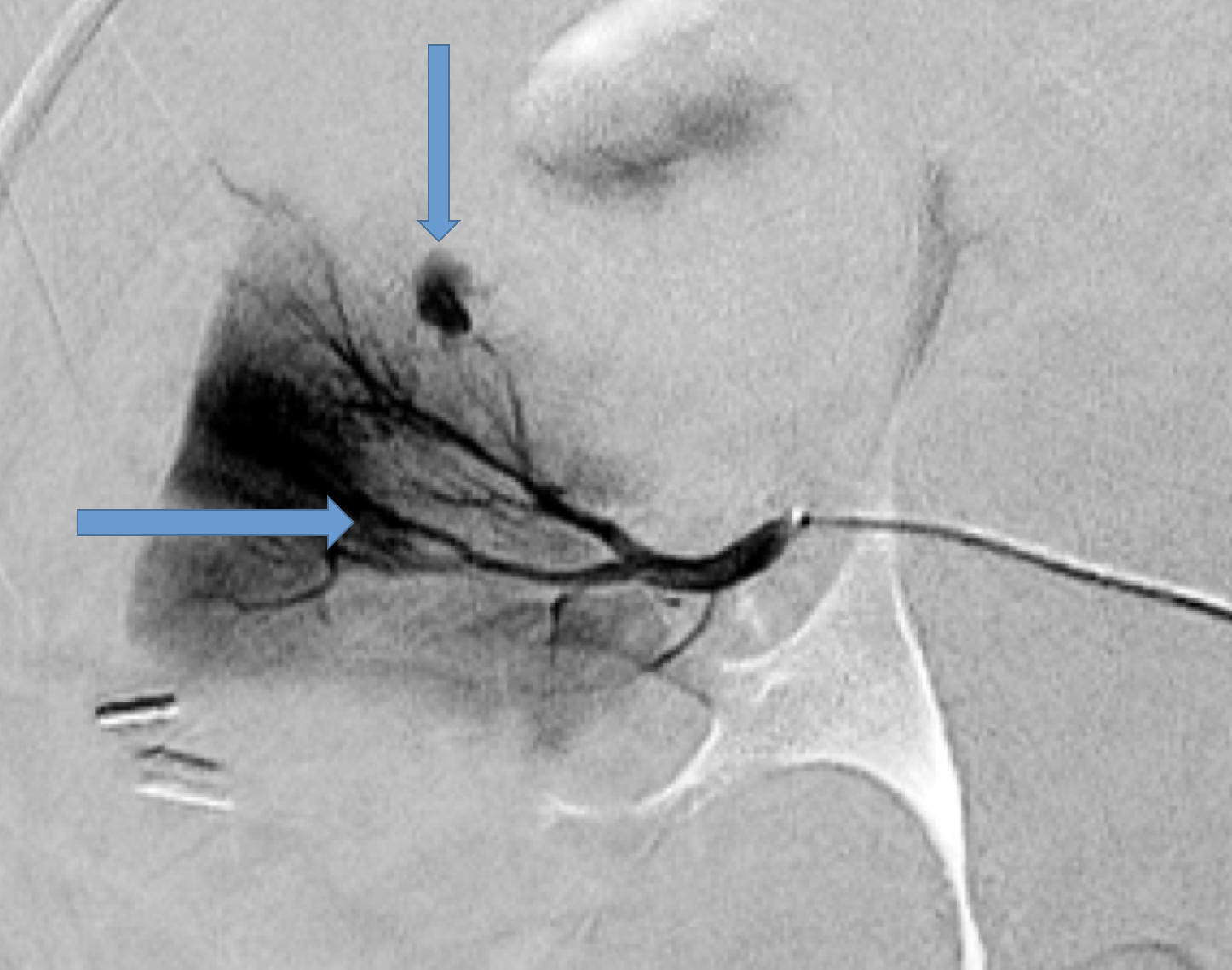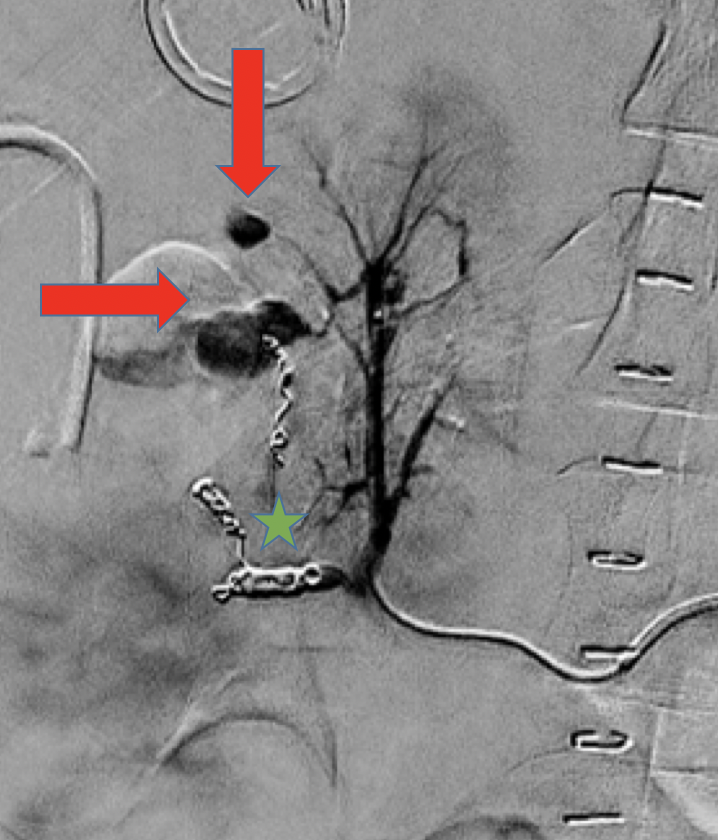IR Management of Splenic and Renal Trauma
Images











The most commonly injured solid organ is the spleen.1 Successful splenic trauma treatment relies on the ability to quickly assess for hemodynamic stability and categorize injury severity. Unstable patients have a low threshold for operative management (laparotomy with splenectomy or splenorrhaphy), while stable patients often undergo non-operative management (NOM).2 Interventional radiology (IR) is used in these cases to perform splenic artery embolization (SAE), which falls under the spectrum of NOM, for stable patients with moderate-to high-grade splenic injuries.
Most stable patients are initially evaluated with computed tomography angiography (CTA), which helps identify candidates for embolization, reveals additional injuries, and serves as a baseline study.1 Findings that warrant embolization include active extravasation, hemoperitoneum, and significant vascular injury, including splenic devascularization, vessel laceration, arteriovenous fistulization, and/or pseudoaneurysm formation.1,3 The American Association for the Surgery of Trauma (AAST) has a classification scheme that incorporates these imaging criteria to grade splenic trauma (Figure 1).4 In general, AAST grade IV-V injuries are managed with IR-guided SAE.1
An initial celiac artery angiogram is performed using standard angiographic technique to evaluate collateral flow and the extent of injury.5 The tortuous splenic artery is subsequently catheterized for angiogram and SAE.5 There are two approaches to SAE, proximal and distal. In the proximal approach, the splenic artery is embolized distal to the origin of the dorsal pancreatic artery to prevent pancreatic ischemia, but proximal to the distal splenic branches.1,6 This lowers arterial pressure to the spleen in the setting of trauma, but it also allows low-volume splenic perfusion via small-vessel collateralization to prevent splenic necrosis.6 The distal approach is more challenging and often performed using a microcatheter to embolize small branching vessels feeding the splenic parenchyma at a focal site of injury.6,7
Distal embolization allows for greater native blood supply via preservation of the splenic artery and flexibility for additional interventions if needed.5 However, the distal approach is not always technically feasible, and it is often considered only when the injury involves an accessible, focal area of the organ.6 Indeed, proximal embolization is performed more often given its efficiency, shorter procedure time, decreased radiation exposure, and lower incidence of complications requiring ICU or surgical management.1.5 Proximal embolization, moreover, is associated with a lower rate of segmental splenic infarction than distal embolization.1 However, proximal embolization results in permanent occlusion of the splenic artery, precluding further endovascular intervention for potential rebleeding. 5
Embolic agents used in SAE include absorbable gelatin sponges, coils, and particles. Sponges are easy to use but their effect is temporary, allowing for vessel recanalization within a few weeks.3 Although absorbable gelatin sponges restore flow to healed tissues, they are associated with a higher risk of rebleeding and infarction with occlusion of distal/collateral vessels. 8 Coil embolization has a lower rate of life-threatening complications, can keep vessels patent over the long term, and be more accurately targeted to the injured area compared to absorbable sponges.1 The downside to coils is that they are permanent, and undersized coils can migrate.3 Particles can reach small arteries that are too distal for a catheter to reach, causing permanent occlusion.3 However, they must be deployed upstream from the target, thus often causing non-target embolization.3 Because the spleen has an end-organ vascular supply, coil embolization is preferable in splenic trauma, as the procedure balances the need to achieve hemostasis with the need to minimize complications.
Case No. 1: Splenic Artery Embolization
We performed a splenic artery embolization in our 4D-CT suite on an 18-year-old driver whose car hit a building. The patient presented with a seatbelt sign, abdominal pain, and a positive Focused Assessment with Sonography for Trauma (FAST) exam (Figures 2-4).
Splenic artery embolization has a low failure rate (4-12%) and lower complication and mortality rates compared to laparotomy or observation.2,9 Most patients retain splenic function and can return to normal activity within three months.2 Potential minor complications include post-embolization syndrome and contrast-induced nephrotoxicity, which are treated conservatively.2 Large infarctions or infections (splenic abscess) requiring splenectomy can occur but are uncommon.8 As mentioned above, small parenchymal infarction is more frequent with the distal approach.8 Pancreatic infarction is seen with embolization proximal to the dorsal pancreatic artery or in the absence of collateral vessels to the pancreas.8 Late complications include pseudoaneurysm and delayed splenic rupture.10 High-grade splenic injury and pre-existing splenic disease are important predictive factors for SAE failure, with up to 25% failure rates occurring in high-grade injuries.9,11
Renal Trauma
Renal injuries account for 1-5% of all trauma, including blunt (most common), penetrating, and iatrogenic.12 Compared to other solid-organ injuries, high-grade renal trauma is less frequently treated surgically, as it usually results in total nephrectomy and loss of renal function.6,13 Three absolute indications for surgery include life-threatening hemorrhage, renal pedicle avulsion, and uncontrolled expanding retroperitoneal hematoma. 12
>
Non-operative management, including IR-guided renal artery embolization, is the standard of care for most stable renal trauma patients and is safe to use in selected hemodynamically unstable or penetrating injury patients.12,13 Similar to splenic injuries, renal trauma is often evaluated with CT imaging and graded according to an AAST injury classification scheme (Figure 5).4 Findings likely to warrant embolization include active arterial bleeding, large perirenal hematomas, and pseudoaneurysms.2,13
Grade I-II injuries are usually self-limited and managed conservatively.9,10 Grade III-V injuries benefit most from RAE, with the goal being to avoid surgery. 9 Key factors in that decision include AAST grade, mechanism of injury (penetrating often requires surgery), and severity of other presenting traumatic injuries.2,12 Surgery is often preferred in cases of severe hemodynamic instability, severe injury to other abdominal organs, urine leakage, and injuries to more than 50% of the kidney.9 Although RAE is sometimes associated with the need for additional endovascular intervention for recurrent bleeding, it preserves renal function.12,13
An aortogram is initially performed to determine the level of takeoff and to assess for variant anatomy (which can also be evaluated on CT) of the renal arteries. Variant anatomy is common, with the most frequent anomaly being accessory renal arteries that usually arise from the aorta and can perfuse either the upper or lower renal poles.12 Identifying variant renal anatomy is essential in RAE to localize the site of contrast extravasation or vascular injury. 12 Similar to SAE, there two approaches to RAE, non-selective and selective. Non-selective is usually chosen when total devascularization is desired without regard for preserving renal function, such as for a shattered kidney.2,12 On the other hand, selective embolization with a microcatheter is more frequently performed for renal trauma, as it minimizes infarction and maintains function of viable portions of the kidney.12,14 This is important; similar to the spleen, the kidneys have end-organ vascular supply with limited to no intrarenal collateral vessels.14
Embolic agents used in RAE include coils, particle/liquid embolics, and absorbable gelatin sponges. Metallic coils are the most commonly used;2,12 they can be placed close to the injury to treat a variety of post-traumatic renal sequela, including hemorrhage, arteriovenous fistulas, and pseudoaneurysms.12 Although particle/liquid embolics and absorbable gelatin sponges are occasionally used, they have similar disadvantages as when they are used in SAE, such as non-target embolization and a higher incidence of ischemia and/or rebleeding.3 Non-target embolization in RAE can potentially affect the spinal arteries, lower extremities, or bowel.12 Traumatic injury to the renal artery can be treated with either a stent graft or an uncovered stent with coils.12
Case No. 2: Renal Artery Embolization
We performed an RAE procedure in our 4D-CT suite on a 30-year-old status post-accidental gunshot injury to the chest and abdomen. The patient was hypotensive with a positive FAST exam (Figures 6-11).
Overall, RAE is highly successful and well tolerated.14 Although uncommon, potential short-term complications include post-embolization syndrome, contrast nephrotoxicity, and infection.12 Long-term complications include pseudoaneurysm or arteriovenous fistula, and possible reduced renal function.2 Importantly, high-grade trauma is associated with repeat embolization and is a risk factor for the development and/or worsening of hypertension.7,15
References
- Patil, Mangaladevi S., et al. Update: Splenic Artery Embolization in Blunt Abdominal Trauma. Semin Interv Radiol. 2020; 37(1):097–102.
- Keefe, Nikki, et al. IR Playbook: A Comprehensive Introduction to Interventional Radiology. Springer International Publishing; 2018.
- Vaidya, Sandeep, et al. An Overview of Embolic Agents. Semin Interv Radiol. 2008; 25(3):204–215. doi 10.1055/s-0028-1085930.
- Kozar, Rosemary A., et al. Organ Injury Scaling 2018 Update. Journal of Trauma and Acute Care Surgery. 2018;85(6):1119-1122.
- Imbrogno, Brian, Charles, Ray. Splenic Artery Embolization in Blunt Trauma. Semin Interv Radiol. 2018;29(2):147-149.
- Warhadpande, Shantanu, et al. Pocketbook of Clinical IR: A Concise Guide to Interventional Radiology. Theme; 2019.
- Osterberg, E. Charles, et al. Renal Trauma Increases Risk of Future Hypertension. Urology. 2018;116:198-204.
- Schnüriger B, Inaba K, Konstantinidis A, Lustenberger T, Chan LS, Demetriades D. Outcomes of proximal versus distal splenic artery embolization after trauma: a systematic review and meta-analysis. J Trauma. 2011;70(1):252–60.
- Padia, Siddharth A., et al. Society of Interventional Radiology Position Statement on Endovascular Intervention for Trauma. J Vasc Interv Radiol.2020;31(3).
- Leeper WR, Leeper TJ, Ouellette D, Moffat B, Sivakumaran T, Charyk-Stewart T, et al. Delayed hemorrhagic complications in the nonoperative management of blunt splenic trauma: early screening leads to a decrease in failure rate. J Trauma Acute Care Surg. 2014;76(6):1349–1353.
- Maarouf AM, Ahmed AF, Shalaby E, Badran Y, Salem E, Zaiton F. Factors predicting the outcome of non-operative management of high-grade blunt renal trauma. Afr J Urol. 2015;21(1):44–51.
- Ramaswamy, Raja S., and Michael D. Darcy. Arterial Embolization for the Treatment of Renal Masses and Traumatic Renal Injuries. Techn Vasc Interv Radiol. 2016;19(3):203-210.
- Resch, Thomas, et al. Penetrating Renal Trauma: Nonoperative Management is Safe in Selected Patients. The American Surgeon. 2019;85(3):266-272.
- Sauk, Steven, and Darryl Zuckerman. Renal Artery Embolization. Semin Interv Radiol. 2011;28(4):396-406.
- Lanchon C, Fiard G, Arnoux V, Descotes JL, Rambeaud JJ, Terrier N, et al. High grade blunt renal trauma: predictors of surgery and long-term outcomes of conservative management. A prospective single center study. J Urol. 2016;195(1):106–111.
Citation
. IR Management of Splenic and Renal Trauma. Appl Radiol.
February 3, 2022